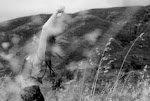
Jardín Tropical
Antonio Seguí says he got interested in painting when he was 8 years old. He lived in Villa Allende, Córdoba, Argentina, in a rural area in the mountains. It was the 40's and there wasn't much going on in his town.
He grew up with his parents, sister, twin brothers and grandmother who was the one that urged him to pursue a career in art.
When he turned 18, his grandmother became his sponsor. With the money he got from her, he traveled to Paris to study but he wasn't a steady student in any academy, he only took courses on the topics of his interest and visited a lot of museums to learn.
When his grandmother, Ana, passed away, he quickly became an adult and decided that he was going to be an artist and he was going to live from his art work. He started traveling through Latin America and producing art and participating in exhibitions. He had a talent for connecting with other people, artists of all sorts and intellectuals. He set up his own workshop in the 60's in Paris and became famous by age 30.
What is most representative of Segui's work, a hallmark of his creations that helps us identify him, is a little country man with a black hat on his head that he often draws. He says he paints that little man all the time because it reminds him of his childhood in Cordoba. He uses the little man's figure in different ways, because, of course, he has evolved with him, so you see him in varied subject matters.
Women didn't use to be out in the streets so much back in those times, they were expected to be at home, with the family, that’s why he rarely paints them. He paints little men, preoccupied, minding their own business, staying in their own way, showing little concern for others. Antonio Seguí has never seen his grandfathers nor his father without a hat.
Seguí is 77 years old now, and works every day, from 7 am, even the weekends. What drives him to do that? 7 am is the time his little men in a hat wake up and come out for a walk on the streets of fragmented chaos and alienation, the same chaos he felt as a child, the same feeling he wonders about today. Those little men, he says, will help him paint his perfect picture. He feels that this has not yet happened for him, which is his reason to work and to hope everyday.
Check out his work at Mamba.
xx
Learn more about Seguí: Una charla con I. Schuliaquer. Ed. Capital Intelectual.
Post by: Valeria Mendez Cañas
































